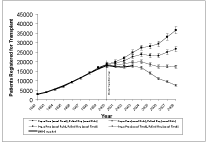| Meeting Brochure and registration form SMDM Homepage | |

|

|
|
||||
Purpose: To estimate the future behavior of the organ allocation waiting list.
Background: The United Network for Organ Sharing recently announced a leveling off of registrations for the waiting list for livers for transplant. While one can only get on the waiting list through registration, there are several ways off. These are transplant, death, inactivation due to medical or other reasons or going outside the UNOS system for a transplant.
 Methods: A discrete-event simulation model of the liver allocation system was constructed. This was calibrated against waiting list length, deaths, lost organ and other data published by UNOS through 2002. The model was then run for an additional 5 - 10 years, depending on the question and computational constraints, under varying assumptions about the patient registration and organ procurement rate. Specifically, we examined 4 combinations of constant rates and constant trends for patient registration and organ procurement. A constant rate means the number of either registering or being procured remains constant year to year. A constant trend means that the registration or procurement rate continues on the same trend as before the transition year. Scenario 1= Org Proc (const Trend)/Pat. Reg. (const Rate), Scenario 2= Org Proc (const Rate)/Pat. Reg. (const Rate), Scenario 3= Org Proc (const Rate)/Pat. Reg. (const Trend), Scenario 4 = Org Proc (const Trend)/Pat. Reg. (const Trend)
Methods: A discrete-event simulation model of the liver allocation system was constructed. This was calibrated against waiting list length, deaths, lost organ and other data published by UNOS through 2002. The model was then run for an additional 5 - 10 years, depending on the question and computational constraints, under varying assumptions about the patient registration and organ procurement rate. Specifically, we examined 4 combinations of constant rates and constant trends for patient registration and organ procurement. A constant rate means the number of either registering or being procured remains constant year to year. A constant trend means that the registration or procurement rate continues on the same trend as before the transition year. Scenario 1= Org Proc (const Trend)/Pat. Reg. (const Rate), Scenario 2= Org Proc (const Rate)/Pat. Reg. (const Rate), Scenario 3= Org Proc (const Rate)/Pat. Reg. (const Trend), Scenario 4 = Org Proc (const Trend)/Pat. Reg. (const Trend)
Results: Peak waiting list for scenario 1 is 2001, and for Scenario 2 is 2005. Waiting lists for Scenarios 3 and 4 continue to rise throughout the simulated range. All projections become statistically distinct between year 5 and 6 (p<.05). Transplants/year rise over the course of the simulated range for the scenarios that assume organ procurement trends continue. Waiting list deaths rise for scenarios where patient registration trends continue and stabilize when registration is constant. The combined transplant, inactivation and waiting list death rates exceed the registration rate for scenario 1 in 2004 and for scenario 2 in 2008.
Conclusion: The liver allocation system is both winning and losing. More patients are transplanted every year but more are also dying. The combination of transplants, deaths and inactivation appears to be starting to surpass the registration rate potentially resulting in a steady-state for the system. The next few years will show which path we are on.
See more of Oral Concurrent Session M - Technology Assessment
See more of The 27th Annual Meeting of the Society for Medical Decision Making (October 21-24, 2005)